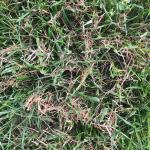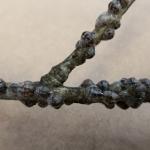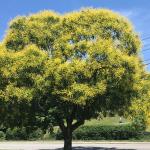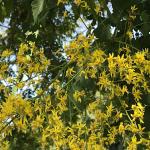A monthly e-newsletter from UMass Extension for landscapers, arborists, and other Green Industry professionals.
To read individual sections of the message, click on the section headings below to expand the content:
Hot Topics
Dieback of Eastern White Pine: Pathogens, Pests and a Changing Climate
Eastern white pine (Pinus strobus) is one of the most economically valuable and ecologically important forest trees in the northeast. It is also an abundant landscape tree with numerous cultivars available through the nursery trade. In recent years, white pines in the region have exhibited symptoms of decline, which include: yellowing/browning needles, premature needle shedding, thinning canopies, undersized shoots and needles, resinosis, branch dieback and death. Widespread health issues for white pine first developed in approximately 2009. In the ten years since these problems became apparent, a great deal has been learned and it’s now known that multiple fungal pathogens, an insect pest and a changing climate are responsible. First and most importantly, white pine needle disease (WPND) is primarily responsible for the symptoms that many trees exhibit and is caused by several fungal pathogens. Branch and trunk cankering, caused by Caliciopsis canker, is also as an important component of the decline complex although disease severity varies by region. Most recently, the eastern white pine bast scale has been identified as an important predisposing agent that helps facilitate Caliciopsis canker. What is particularly interesting about the pathogens and insect pest responsible for white pine decline is that each is known or believed to be native in eastern North America. The widespread distribution of symptomatic trees and lack of a non-native pathogen or insect lead researchers to investigate the role of environmental conditions, which have been altered by a changing climate. What they found was that an increase in temperature and precipitation from May through July has helped to fuel the WPND epidemic. It is believed that the issues facing eastern white pine will only continue but management options do exist to help improve the health and vigor of stressed white pines.
Read more about eastern white pine health issues here:
https://ag.umass.edu/landscape/fact-sheets/dieback-of-eastern-white-pine
Nick Brazee, UMass Extension Plant Pathologist
Questions & Answers
Q: There are little pink patches all over my lawn. What the heck is going on?
A: Prolonged cool, wet weather this spring made it a banner year for red thread, so chances are good that this is what you’re seeing. Red thread is caused by the fungus Laetisaria fuciformis. This fungus overwinters in soil and becomes active in spring. Its spores are dispersed by wind, splashing water, and human activity. The fungus penetrates grass blades through stomata and through wounds.
Red thread occurs in the cooler (60-75°F), wet weather of spring and fall. It is usually seen in the spring before grass growth really takes off. The fungus produces reddish structures on the tips of infected grass blades, and dark pink patches appear in lawns. Red thread is largely a cosmetic issue. Patches eventually become pale and bleached out, and turf can take on a ragged appearance. It will not kill turf crowns or roots, but chronic, severe cases may eventually weaken turf. All turfgrass species are susceptible, though in general perennial ryegrass and fescues are more severely affected. Cultivars vary in susceptibility; resistant cultivars are available. Red thread is exacerbated by low nitrogen fertility, low soil calcium, water stress, and any other condition that slows turf growth.
Fortunately, red thread is relatively easy to manage. Fungal growth slows significantly when the temperature exceeds 75°F, so the disease will disappear when summer heat arrives. Application of 0.2 lbs/1000 ft2 of quick release nitrogen in mid to late spring will help the turf recover. Have a soil test done and ensure that there is adequate calcium, potassium, and phosphorus available. Maintain a soil pH of 6.0-7.0. Ensure that mower blades are sharp to minimize wounding of grass blades. Collection and off-site disposal of clippings may be warranted with severe infestations. Manage thatch, which serves as a nice place for pathogens to hide out. Overseed with resistant cultivars.
Angela Madeiras, UMass Extension Plant Pathologist
Trouble Maker of the Month
Oak Lecanium Scale
The oak lecanium scale, Parthenolecanium quercifex, is a common pest of ornamental trees and shrubs in the eastern US. This soft scale insect (Hemiptera: Coccidae) is primarily a pest on oak but has also been recorded on other species including hickory (Carya spp.) and birch (Betula spp). This insect is very similar to other closely related lecanium scale species, and as such there is often question about their identity as well as whether or not a cryptic species complex exists. Another very closely related insect, the European fruit lecanium or P. corni (also apparently native despite what the name suggests) is found on trees and shrubs in the eastern US and may be confused with the oak lecanium scale.
Oak lecanium and European fruit lecanium are so similar that identification to species requires examination of adults under high magnification or by analyzing DNA. However, even while employing both of those techniques, entomologists may still have a difficult time discerning the two species. Beginning in the summer of 2018 and again in the late spring and early summer of 2019, a widespread outbreak of lecanium scale activity on oak was reported on much of Cape Cod and Martha’s Vineyard. Samples in 2019 from Cape Cod (collected by the Elkinton Lab) and Martha’s Vineyard (originally submitted to the UMass Plant Diagnostics Laboratory) were given to Dr. Joseph Elkinton’s Laboratory (UMass) for analysis using DNA and samples from Martha’s Vineyard were sent to the USDA-ARS-Systematic Entomology Lab in Beltsville, MD for further identification. Jeremy Andersen of the Elkinton Lab reported the following:
“We extracted DNA from the samples provided (immature females) [from Martha’s Vineyard] and compared them to adults collected from oaks on Cape Cod earlier this month. The individuals from both locations were an exact match genetically. Morphological identifications of the adult specimens using the key presented in Gill 1988 suggest that they are Parthenolecanium quercifex (oak lecanium). However, there is much confusion in the literature as to whether or not oak lecanium is in fact a valid species or whether it should be considered the same species as European fruit lecanium (Parthenolecanium corni). Both species have a tendency to reach high densities when trees are stressed by other insect pests, droughts, or lack of nutrients, and/or when natural enemies are affected due to non-target effects from insecticides.”
Dr. Gregory Evans of the USDA-ARS-Systematic Entomology Lab also used morphology to identify insects originating from Martha’s Vineyard as the oak lecanium, Parthenolecanium quercifex.
The oak lecanium scale has one generation a year. Eggs are laid underneath adult females that have a distinctive hemispherical or helmet shape (Fig. 1). The number of eggs laid is dependent on many factors and literature reports range from dozens to several thousands of eggs per female. Eggs are laid in late May and into June. Eggs hatch in June or early July and the crawlers (immatures) migrate to host plant leaves. (Historically, reports from New York indicate that crawler activity occurs in mid-July.) The crawlers feed on the undersides of the leaves, typically along the main veins, using piercing-sucking mouthparts to imbibe plant fluids. The first instars are tiny <1 mm. and are pale yellow/brown in color. The insects molt and become second instars in the late summer/fall and then migrate back to woody tissues, such as host plant twigs, where they will overwinter. (Crawlers are also flattened in comparison to the adults.) In the spring, females begin to enlarge and mature, eventually taking on the distinctive hemispherical shape (Fig.2). Adult females are approximately 4-7 mm. long and 3-5 mm. wide and vary in color from light-dark brown/gray. Adult female oak lecanium scales almost always possess a pair of lateral humps on their dorsal (back) surface when mature.
Lecanium scales feed on the phloem of trees and shrubs generally reducing vigor. High populations can result in stunted foliage, chlorosis, twig death, and dieback, particularly due to the feeding female scales from April-May. Their feeding habits result in copious amounts of honeydew (excrement) that can cover plants and structures beneath infested trees. Honeydew, rich in sugar, may provide a substrate for sooty mold to grow. Sooty mold is black in color and it is not a plant pathogen; however, it can reduce the aesthetic value of the plant it covers. Honeydew and sooty mold in large amounts may both also be a significant nuisance on structures including outdoor furniture, patios, cars, etc.
Lecanium scales are known to have a large number of predators, parasitoids, and pathogens which often keep populations under control. Populations of lecanium scale are known to rapidly increase especially on urban trees or trees under stress. Monitoring trees for lecanium scale is an important part of management due to the ability for populations to rapidly increase as well as the likelihood of predators and parasitoids to control populations. (Therefore, management may not be necessary from year to year, but rather occasionally when population outbreaks occur. It is also important to preserve natural enemies.)
An insecticidal oil application may be made as a dormant spray, targeting the overwintering 2nd instar nymphs on the host plant twigs during that time of year, at approximately 35-145 GDD, base 50°F. Such reduced risk active ingredients may help avoid unintended suppression of parasite/predator activity. In July, or August, following egg hatch, crawlers may be targeted on the leaves with a foliar applied insecticide if damage symptoms are seen. (Again, preserving natural enemies is very important, and broad-spectrum active ingredients can kill natural enemies as well as pest insects.) Systemic insecticides applied through the soil or bark are also labelled for this pest, and may be applied after bloom.
Active ingredient options labelled for use against soft scales include, but are not limited to: abamectin, acephate, acetamiprid, bifenthrin, carbaryl, dinotefuran, horticultural oil, imidacloprid, insecticidal soap, neem oil, and pyrethrins. Read and follow label instructions for safety and proper use. Each active ingredient comes with different risks to the applicator and the environment. A summary of some of these risks may be found here, but this does not replace reading and following label instructions.
Russ Norton, Horticulture Extension Educator, Cape Cod Cooperative Extension and Tawny Simisky, UMass Extension Entomologist
Plant of the Month
Koelreuteria paniculata, Golden rain tree
Golden rain tree is a deciduous tree with an open-branching, irregularly-shaped habit when young, then maturing to a more uniform rounded crown. It is a medium sized tree, growing 30-40' high and wide. Native to Northern China, Korea and Japan, it is hardy in zones 5 – 8. Plants are best grown in moist, well-drained soil in full sun, but are adaptable to dry soil, and they can tolerate drought, heat, high pH and acidic soils. Leaves are pinnately compound with 7-15 leaflets, growing up to 18” long! In the spring, leaves emerge with a pinkish-bronze to purplish cast and mature to bright or dark green in summer. The leaves may turn to golden yellow in fall, but most of the time the fall color is disappointing. Golden yellow flowers appear in late June or July. Individual flowers are small (about ½”) but occur in long, terminal, 12-15 inch airy panicles. The common name refers to the “golden rain” produced by the falling flowers; the fallen blossoms often form an attractive golden carpet under the tree. The fruits are papery, lantern-like 1½-2” long capsules that change from green to yellow to brown. The brown capsules typically persist on the tree for a long time.
Golden raintree can be used a small shade tree, a lawn specimen tree, street tree or in groupings. Golden rain tree has no serious insect or disease problem, but canker diseases and leaf spots are possible.
Cultivars include:
- 'September' – has a broad-rounded habit and produces masses of yellow flowers in August and September. It is slightly less cold tolerant than the species, and is hardy to zones 5/6 – 8. At zone 5, it may struggle with hard winter conditions.
- 'Fastigiata' – has a distinct columnar form and seldom flowers; is less hardy than the species.
Geoffrey Njue, UMass Extension Sustainable Landscapes Specialist
Upcoming Events
UMass Turf Research Field Day
June 17, 2019
Join us at UMass Turf Research Field Day to hear about and see research projects in the field, network with colleagues, and enjoy continental breakfast and a hearty barbecue lunch. Current UMass research includes studies on the biology and integrated management of turf-damaging diseases and insects, short- and long-term weed management, environmental stress physiology, fertility, drought management, and golf and sports surfaces, as well as a range of National Turfgrass Evaluation Program fine turf trials.
Registration and Additional Information.
Other Upcoming Events:
- 7/17: Turf Field Day
- 7/18: In-Season Lawn and Landscape Turf Training
- 9/7: In Celebration of Trees with Dr. Michael Dirr
- 9/14: Landscape and Forest Tree and Shrub Disease Workshop
- 10/9: Tick Webinar - 2019 Tick Updates from the UMass Laboratory of Medical Zoology
- 10/17, 10/31 & 11/14: Invasive Insect Certification series
For more information and registration for any of these events, go to the UMass Extension Landscape, Nursery, and Urban Forestry Program Upcoming Events Page.
Additional Resources
For detailed reports on growing conditions and pest activity – Check out the Landscape Message
For commercial growers of greenhouse crops and flowers - Check out the New England Greenhouse Update website
For professional turf managers - Check out Turf Management Updates
For home gardeners and garden retailers - Check out home lawn and garden resources. UMass Extension also has a Twitter feed that provides timely, daily gardening tips, sunrise and sunset times to home gardeners, see https://twitter.com/UMassGardenClip
Diagnostic Services
A UMass Laboratory Diagnoses Landscape and Turf Problems - The UMass Extension Plant Diagnostic Lab is available to serve commercial landscape contractors, turf managers, arborists, nurseries and other green industry professionals. It provides woody plant and turf disease analysis, woody plant and turf insect identification, turfgrass identification, weed identification, and offers a report of pest management strategies that are research based, economically sound and environmentally appropriate for the situation. Accurate diagnosis for a turf or landscape problem can often eliminate or reduce the need for pesticide use. For sampling procedures, detailed submission instructions and a list of fees, see Plant Diagnostics Laboratory
Soil and Plant Nutrient Testing - The University of Massachusetts Soil and Plant Nutrient Testing Laboratory is located on the campus of The University of Massachusetts at Amherst. Testing services are available to all. The function of the Soil and Plant Nutrient Testing Laboratory is to provide test results and recommendations that lead to the wise and economical use of soils and soil amendments. For complete information, visit the UMass Soil and Plant Nutrient Testing Laboratory web site. Alternatively, call the lab at (413) 545-2311.





